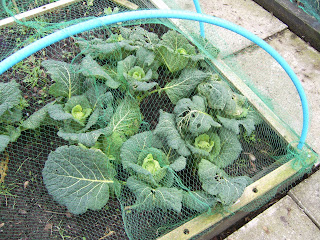At the time I was a little concerned about there being a hole in the liner as the local kids had been on the plot and had used bricks and even the ceramic frog statue to break through the thick ice.
As the weather improved slightly my fears were justified as I came on site one morning to discover that there was very little water left in the pond at all.
 |
| Hole in the pond liner, each arm being just over an inch long |
I took the opportunity to clear out a lot of muck and fallen leaves from the bottom of the pond, and whilst doing so I discovered a huge hole in the bottom of the liner.
There had been a spare square wooden baton left next to the pond, and when I placed it next to the hole the edges lined up almost perfectly.
It appears that when breaking the ice with the stick the local kids had pushed straight through the liner.
Whilst clearing out the pond I discovered three frogs which had been hibernating in the muck underneath the old slate which allowed them to climb in and out of the pond.
Now that I had found the frogs it became important for me to fix the hole as soon as I could to help them survive if the water froze again.
I got advice from my local aquarium shop and took several pieces of plastic and some waterproof adhesive and fixed the hole. I then added about 200 litres of water which nearly half filled the pond.
 Some time ago I had decided to get a cheap polytunnel which I hoped would last at least one season and give me some idea of whether a poly tunnel was good enough, or if I would need to invest in a greenhouse instead.
Some time ago I had decided to get a cheap polytunnel which I hoped would last at least one season and give me some idea of whether a poly tunnel was good enough, or if I would need to invest in a greenhouse instead.
I looked on Ebay and managed to win a 8' x 6' poly tunnel for £42. This was easy to erect and was soon up and in place.
 |
| Start of the decked area |
My original plan for the area between the poly tunnel and the pond was to lay flagstones to make a patio area, but after seeing the amount of flooding that this area was prone to I changed my mind and started to build a slightly raised wooden deck.
 |
| Weed fabric over the rotivated area |
The ground where the deck, poly tunnel and eventually a shed would be put was very uneven and had a thick layer of silt which was causing any rain to stay on the surface, so before I could start to install anything I had to get out the rotivator again and try to level the ground, covering it all over with a layer of weed fabric.
 |
| Essential Equipment |
I had also been very lucky on Freecycle and got a garden table and four chairs - essential allotment equipment!
 |
| Victoria Rhubarb |
The rhubarb bed was now nearly ready to be planted up so I brought my Victoria rhubarb from home so it could be transplanted as soon as the bed was properly weeded.







































